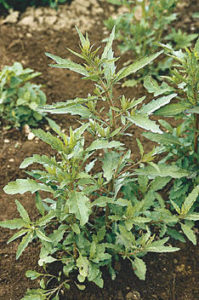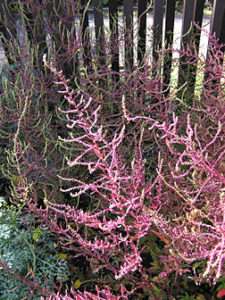 |
| Epazote can be grown in Maine and added to Mexican dishes. Photo courtesy of Pete Nutile, Photographer, Johnny’s Selected Seeds. |
by Jason Moore
Local farmers’ markets are an excellent source of traditional organic produce, such as sweet corn, peas and tomatoes, but also of regional and ethnic favorites, such as fresh fiddleheads, chicory, okra or chayote. As regional demographics change and new immigrant communities appear, farmers’ markets reflect these changes, and previously unknown Mexican-American foods and spices are now common in farmers’ stalls from Springfield, Massachusetts, to Ellsworth, Maine. A lesser-known plant seasoning that is used throughout Latin America but is only beginning to be found in New England markets is epazote (Chenopodium ambrosioides, syn. Dysphania ambrosioides). Pronounced eh-paw-ZOE-tey, this plant has a wonderfully diverse number of uses but is especially effective in traditional Mexican dishes.
Although we often think of soft corn flour tacos with beans and cheese as typical Mexican fare, the Mexican food that is served today in local or chain fast food restaurants is a pale imitation of a cuisine with over 5000 years of history and marked by regional variety and difference. To understand the unique flavors and tastes common in the Mexican cocina, one must start in ancient Mexico where the Aztecs founded a city sate in what would become Mexico City, and the Maya thrived in what is now the Yucatan and Guatemala.
Aztec agriculture in central Mexico before the arrival and conquest of the Spanish was based on several domesticated plants but was dominated by squash, beans, chili peppers, tomatoes and, primarily, corn. As Aztec civilization developed, expanded and eventually urbanized with the legendary city of Tenochtitlan, the diet eventually included peanuts, sweet potatoes, yucca, guavas, amaranth, lima beans and green tomatoes, with dogs and turkeys as sources of animal protein.
To the south of the Aztecs, the Mayans were also successful agronomists propagating corn, chili peppers and black beans, while simultaneously using bees to pollinate orchards that produced an abundance of pineapples, papaya, mamey sapote and sapodilla (Manikara zapota), a fruit that looks similar to a potato but tastes like a mix between root beer and molasses. As with the Aztecs, corn dominated the Mayan diet, but the Mayans were fortunate and could often supplant their primary grain with such root and tuber crops as yucca, sweet potato and jicama.
Both Aztecs and Maya consumed alcohol: The Aztecs fermented and drank a potent juice of the agave plant, while the Maya consumed a corn- and honey-based alcohol. Both cultures consumed hot liquid chocolate drinks that were often mixed with spices and flavoring such as vanilla and chili; but it would have been unusual for a common Aztec or Mayan to consume chocolate, as it was generally used ritualistically by the ruling and elite classes.
With the arrival of the Spanish, the indigenous diet drastically changed as such Old World crops as citrus fruits, rice, sugar cane, pork, chicken and beef were adopted. While we now think of spices such as oregano, cinnamon, cumin, nutmeg and black pepper as the spices of Mexico, these flavors were adopted by Spain through its cultural interactions with the Middle East and the cultures of the greater Mediterranean region.
Cultural Diversity Creates Mole Sauce
This unique cross-pollination of Old and New World ingredients and cultures produced what is now considered the traditional sauce of Mexico, the mole (pronounced “moe-lay”). Originally called mollis, this sauce is unique in its regional variety and ingredient diversity, which can include anything from chilies and chocolate, tomatoes and peanut, garlic, green and white pumpkin seeds (Pepitas de Calabaza), annatto seeds (achiote), black pepper, anise, cloves and cinnamon, to coriander and cumin. Epazote is a common and striking addition to moles throughout Latin America.
 |
| The flower and seed stalks of epazote are ornamental – although the plant may become weedy (like its relative, lambsquarters) if it goes to seed; and an essential oil from the plant can be toxic, which is why the plant shown here was growing in the Poisonous Plants section of the Montreal Botanical Garden. English photo. |
Growing Epazote
Also called Mexican tea, wormseed and pazote, epazote is from the indigenous Nahuatl word for skunk, epatl. The plant is considered an annual here but a perennial in warm climates, and in some areas is considered weedy or potentially invasive. It is related to lamb’s quarters, so it could become a pesky garden weed even in colder climates if it is allowed to go to seed.
In our area, Johnny’s Selected Seeds suggests sowing epazote every two to three weeks from spring through early summer for a steady harvest of green leaves. Plan on 55 days to harvest.
The green, multi-branched, reddish-stemmed plant prefers a sunny location with moist, sandy soils and can grow from about 2 to 4 feet tall. The leaves are sharply toothed, and the plant produces small, yellowish-green clusters of flowers along its stems. These flowers produce thousands of tiny black seeds. Epazote generally flowers from July to October, with seeds ripening between August and October. The hermaphroditic flowers are wind-pollinated.
Epazote exudes a powerful and distinctive odor, considered by some to be overpowering and even repugnant. The plant can be cultivated in any traditional garden or bed and will prosper in a window box or in a sunny herb garden. As epazote originated in a semitropical environment, it is hardy to zone 8 and will certainly be damaged by cold and frost.
Chemical Constituents
Chemically epazote is plentiful in the essential oil carminative as well as monoterpene and monoterpene derivatives. Carminative, considered a digestive aid since the seventeenth century, controls intestinal cramps and flatulence.
Monoterpene and its derivatives have been known since the late nineteenth century as an effective vermifuge, expelling intestinal worms and parasites. Both the archaic and modern people of Mexico and Latin America continue to use epazote in this fashion and along traditional lines, either consuming epazote as a tea or as a decoction once daily for three and five days.
Recent studies conducted by the World Health Organization suggest that epazote was 100% effective against the intestinal parasites Ancylostoma (hookworm) and Trichuris (whipworm), and 50% effective against roundworm (Ascaris). In addition, a 2001 study reported that epazote was 100% effective in eliminating the common human tapeworm (Hymenolepsis nana), although this study has not been confirmed by the U.S. Department of Agriculture or the Food and Drug Administration.
The seeds and fruit of epazote also contain ascaridole, a mild sedative and minor pain reliever, and control for nematodes and for the tropical parasite Trypanosoma cruzi. It also fights malaria. Note that due to the high concentrations of ascaridole in epazote seeds, a health care practitioner should be consulted before using them; consumption has been documented to cause dizziness, vomiting, and in several cases death. Pregnant and nursing women should also note that the plant was used in folk medicine for birth control. For more information on the medicinal aspects of epazote, see www.rain-tree.com/epazote.htm.
In the Kitchen
Epazote is similar to cilantro, dandelions and mustard greens in that it has a distinctive odor, taste and flavor, and novice cooks should be cautious when adding fresh or dried epazote to a meal. It can invite immediate and powerful reactions ranging from pleasant surprise to intense aversion. The bouquet of the leaves, stems and flowers of epazote is often described as similar to “kerosene,” “skunk” or “musky lemon,” with a taste between weak anise and strong licorice.
The leaves are best used fresh or dried, akin to parsley or sage, and traditional Mexican cuisine often includes a large portion of stem with leaves in stews and bean dishes. Epazote does have a commanding flavor that has been infused into the cuisine of Mexico for centuries, and its distinct flavor is best enjoyed in a traditional mole sauce or a bean stew.
Mole Sauce with Epazote
This is a simple version of a common sauce from the greater Tlaxaca area of Central Mexico.
6 ripe red tomatoes
6 to 8 chilies (Jalapeno or Tabasco are the most traditional, with about 5,500 and 120,000 Scoville Heat Units per pepper, respectively.) Remove the seeds and stems.
3 cloves of garlic, peeled and crushed
1 c. finely chopped onions
1 tsp. dried oregano
1 tsp. ground cumin
1/4 tsp. ground cinnamon
1 ounce dark, unsweetened chocolate, chopped
2 Tbsp. corn oil
1/4 c. epazote
Roast tomatoes in a 400-degree oven until the skins are tender and dark. Let them cool and cut them into quarters. Dice peppers and purée tomatoes and peppers in a blender.
In 2 Tbsp. of corn oil, fry onions, garlic, oregano, cumin and cinnamon in a stockpot till cooked clear. Mix in puréed tomato, chili mix and epazote and chocolate. Let the sauce simmer for more than five minutes or until thick, with the consistency of a hearty soup.
This mole can be used with baked chicken or the more traditional turkey, and it can be thinned with condensed canned stock. Side dishes should include sweet potato and avocado salad.
Black and Pinto Bean Stew
1 1/2 c. dry black beans
1 c. dry pinto beans
2 Tbsp. corn oil
1 1/2 c. diced onion
2 cloves minced garlic
1 c. diced bell pepper
1/2 Tbsp. chili powder
2 tsp. ground cumin
2 tsp. dried oregano
1 sprig epazote (3 to 6 inches long)
1/2 tsp. ground cinnamon
1 15-ounce can crushed tomatoes, undrained
1 can chicken stock or water
Soak dry beans overnight in a water bath sprinkled with salt. Strain beans and remove any dirt or debris. Set aside.
Sauté onion, garlic and bell pepper in corn oil with chili powder, cumin, oregano and cinnamon for about 10 minutes, until the onion is cooked clear.
Add beans to onion and pepper mixture and cover with chicken stock or water. Cover the pot and boil. After 10 minutes add the epazote sprig. Cook till beans are soft and then add the crushed tomato and a sprinkle of salt. Remove the epazote before serving. Serve with rice. Garnish with cheese or salsa and corn chips.
Jason Moore is a writer, teacher and unrepentant gardener who lives in Somerville, Massachusetts.
